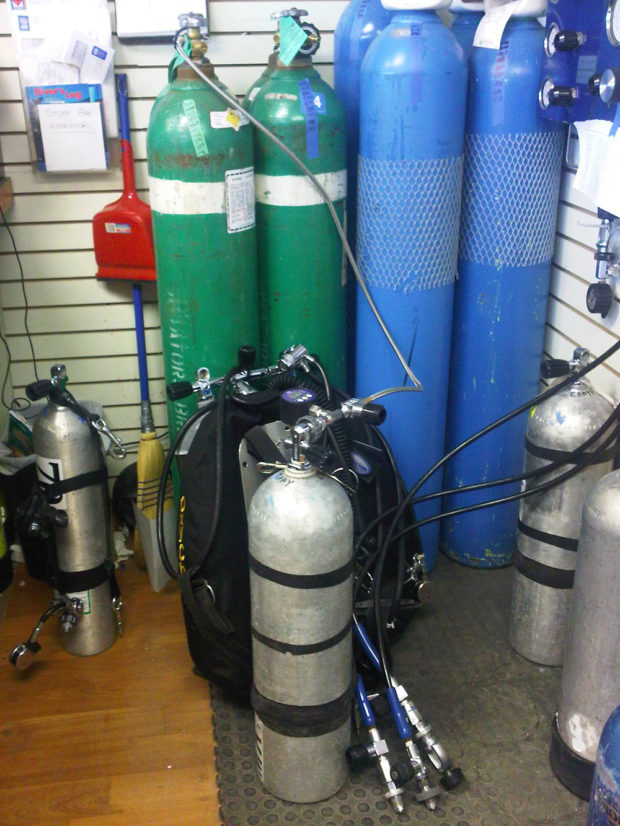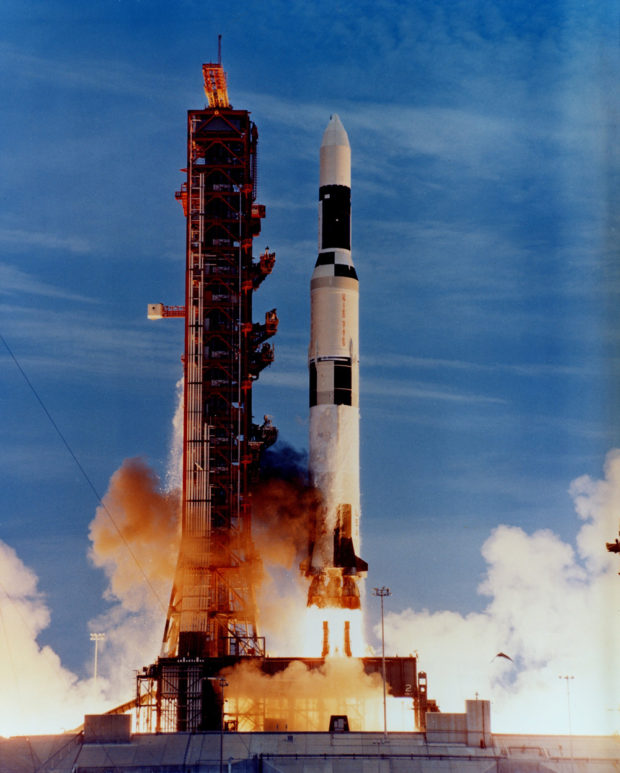Helium RI$ING?
Reserves are going down, which may mean prices go up? And how might that affect the future of mixed gas technical diving? The answer is up in the air.
Text by Jeremy Heywood and Lee Newman

The future of mixed gas technical diving may be uncertain due to the dwindling earthly reserves of the second most abundant element in the universe.
Because it does not induce narcosis, helium is critical as a partial replacement, as in trimix, or full substitute, as in heliox, for nitrogen, in breathing mixtures to depths greater than 100 feet (30m). But supplies of the gas are running out.
Helium is a non-renewable resource. Formed over eons by the radioactive decay of naturally occurring minerals in the earth’s crust, helium accumulates in natural geological voids that also trap natural gas. The only commercially feasible source of helium is from this natural gas, and only then if concentrations are high enough – usually 0.04 to 0.65 percent. Once extracted it is stored or refined to varying levels of purity for commercial sale. Producing helium synthetically – bombarding lithium or boron with high velocity protons, for example – is not economically viable at this time.

Hooked on Helium
The largest demand for helium comes from the medical imaging and cryogenics sector; MRIs use superconducting electromagnets cooled by liquid helium, which accounts for 28 percent of total annual usage. Another 26 percent goes to pressurizing and purging rocket engines, 20 percent for welding, and 13 percent to create inert atmospheres for the manufacture of fibre optics, electronics and in food production. Only about two percent of helium consumption is used for breathing mixtures.
Once used, most helium is released into the atmosphere and is gone forever. Due to its low cost at present, it’s much cheaper to vent away than to recycle. In the face of an increasingly delicate balance between supply and demand, even the gas industry sees the need to reduce helium loss. “It’simperative that the helium-producing industry work with heliumend users to conserve, recover and recycle this resource,” helium company engineer Donald Bowe wrote in 2004.
And the demand for helium is growing. Globally, we used about six billion cubic feet of helium in 2009, and estimates suggest that consumption will grow to eight billion cubic feet per year by 2020.
The main natural reserves of helium are in the United States, the Middle East, and Russia, and the world’s largest stockpile is the National Helium Reserve, operated by the United States Bureau of Land Management (BLM), near Amarillo, Texas. But in 1996, the Helium Privatization Act mandated the sell-off of this reserve by 2015. The 2010 Committee on Understanding the Impact of Selling the Helium Reserve, urged caution, saying that recent developments in the demand for, and sources of, helium, might warrant another look at this decision. The committee pointed out that principal new sources of helium will be in the Middle East and Russia, and if the sell-down of America’s reserves continues, then the U.S. will become a net importer of helium over the next 10 to 15 years. The committee has recommended that Congress reconsider whether the sale of substantially all federally owned helium is still in the nation’s best interest.

In the fall 2010, the BLM responded to the recommendations of the committee and raised the price of stockpiled helium by almost 16 percent. Rob Cockerill of Gasworld Magazine said this price increase, “Will have a far reaching impact on the cost of helium, since roughly one-third of the world’s helium production is refined directly from BLM crude”. And major players in the global helium market all project helium supply troubles of one kind or another. Phil Kornbluth, Executive Vice President of Matheson Tri-Gas, warns of “Increased scarcity of helium, and higher costs, not too far down the road, with no relief in sight until major new sources commence supply in 2013 or 2014. In contrast, another company – Air Products – projects, “Availability of viable helium reserves will not become a limitation to continued helium demand until sometime around 2050.”
That sounds like good news, but 2050 is only a few decades away.
Academic Alarm
Some academics take a more alarmist view. Among them is Dr. Robert Richardson, who won a Nobel Prize in 1996 for his work with superfluid helium and who was the co-chair of the aforementioned 2010 Committee on Understanding the Impact of Selling the Helium Reserve. In a lecture given last year he argued, “That the world will run out of helium in 25 years,” give or take five, based on world usage in 2008. “What’s taken 4.7 billion years to create will be dissipated in little over 100 years,” he predicts, suggesting that the only way to encourage recycling and slow the wasteful use of helium is to significantly increase the price. “Helium is far too cheap… better to raise the price by a factor of 20 now to discourage frivolous use rather than a factor of 10,000 in 25 years.”
Deep Pockets?
So what does all this mean for the technical diver? On a typical 50 minute, 35 percent helium trimix dive, a tech diver consumes approximately 100 cubic feet (3 cubic metres)of helium at a current dive store fill cost of about $65. At Richardson’s suggested 20-fold increase in price, the helium cost would skyrocket to $1,300 for the same fill. In other words, a trimix diver would be exhaling helium at a rate of $25 per minute. This would surely put open circuit trimix diving beyond the reach of almost everyone.
And because of its unique properties there’s no practical replacement for the technical diver. Helium’s extremely low solubility makes it metabolically inert and non-narcotic. It’s also chemically inert and non-flammable. Hydrogen in conjunction with oxygen (hydrox)has been used in commercial diving operations for dives to very great depth, but it’s explosive, and hydrogen poses its own narcosis problems. Other exotic mixes utilizing neon, argon, and other noble gases remain experimental and have no useful application in the technical diving arena.
Rebreathers Recycle
Perhaps the widespread use of closed circuit equipment would mitigate the potentially prohibitive cost of helium. A closed-circuit trimix rebreather requires approximately 20 times less helium than its open circuit analog. For the moment equipment and training costs of rebreather diving are significantly higher than those for open circuit, but there’s a potential game changer afoot in recreational dive training. PADI is set to launch its first recreational closed circuit rebreather course in 2011. PADI’s adoption of rebreather technology can only mean training costs will become more competitive, and rebreather hardware will get more prominence in the windows of dive stores. Add to this the existence, for several years now, of training by such agencies as RAID, which introduces newbies to rebreather diving from the get-go; open circuit is bypassed completely. This said a paradigm shift in the mainstream tech diving community from open to closed circuit would most likely take a decade or more.

So far, the diving industry, at least here on Canada’s west coast, seemingly has been untouched by the vagaries of the global helium market. Mike Delaney, manager of The Edge Diving Centre in North Vancouver, has received no indication from his supplier that the cost of helium will increase, but he concurs that if helium prices do substantially rise, its use “May have to evolve or be limited to science and commercial diving applications.”
On this question of a helium shortage, an informal poll of Vancouver area technical divers elicited opinions ranging from the non-committal: “Oh, that old story again,” to the unequivocal: “It’s a bunch of BS.” But in my view there is cause to take heed for several reasons:
- There is a finite amount of helium on the planet.
- Once helium is exhaled it is gone. Forever.
- The largest helium stockpile on the planet is being systematically sold-off.
- New helium production facilities that are being relied upon to meet the increasing global demand are located in geopolitically unstable parts of the world.
- The further away it is produced, the more expensive it is to get here.
- At only two percent of the helium market, breathing gas customers are likely the first accounts to be dropped by gas companies if critical shortages occur.
The cost of helium will certainly rise; how high is open for debate. But the real question is how much longer will supplies last? Because as goes helium, so does technical diving as we know it today. And the future of both is up in the air. Literally.







